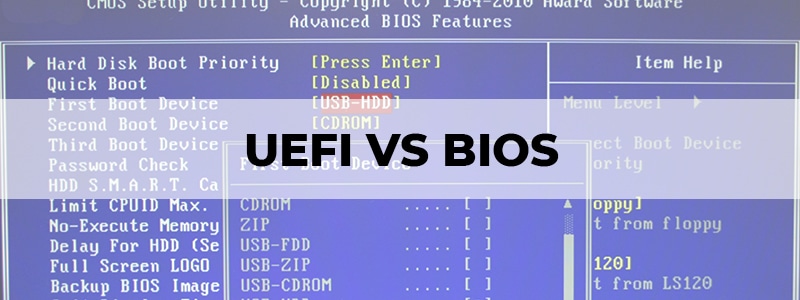
With Intel’s announcement to completely remove BIOS support from all their chipsets, you might be left wondering and wanting to know more about the replacement. Intel has announced its plans to implement UEFI on all chipsets by the end of 2020. What exactly is it, and how does it fare in a UEFI vs BIOS comparison?
Comparing legacy BIOS vs UEFI is, in fact, even more interesting, since many manufacturers will still refer to the firmware as the BIOS to continue with the preferred nomenclature that people are used to, and might be confused by the sudden change in. Whatever they’re calling it, chances are most of the PCs you’ll get, and the best gaming motherboards will have the UEFI system.
So, what exactly is better about the UEFI, and what does it have in common with the BIOS?
UEFI vs BIOS: The Differences
The BIOS – as well as the UEFI – is a software used to boot the PC before the OS boots. It’s a low-level enough to boot processes that can then in turn boot the Operating System.
The UEFI does the same but much more efficiently. It allows for faster boot times, more robust security features, as well as the ability to support larger hard drives, as well as graphics and mouse cursors.
What Exactly Is A BIOS?
The BIOS (or PC BIOS, ROM BIOS, or system BIOS) is the computer’s Basic Input/Output System. It’s embedded on a chip where it comes pre-installed on everything from to the best mini-ITX motherboards to the full-sized ones. The BIOS firmware is non-volatile, meaning the settings it keeps, it retains from one powering off to the next, never changing or losing them.
The BIOS works by loading and “nudging awake” the hardware components of the computer. This means ensuring that they work properly, after which it does the same to something called the boot loader. The boot loader must initialize the operating system after that.
Why did the need for the BIOS get obsolete? It didn’t, and that’s why the UEFI does the same tasks. The limitation of the BIOS is that it ran in 16-bit processor mode, with only 1MB of space to work with! A modern PC has multiple hardware devices that need to be initialized all at once, in addition to all the interfaces. This slows the boot process down considerably.
Mostly, users navigated the BIOS to change boot order settings if they had issues. The UEFI, however, has made those very problems obsolete.
UEFI vs BIOS: The Advantages
If your hardware supports UEFI firmware, you can get a boatload of benefits over using a “simple” BIOS. For a computer or device to support UEFI, the hardware on the disk must support UEFI and the system disk must be a GPT disk. While hardware might need upgrading, a professional partition software or expert can convert your MBR disk to a GPT disk to successfully use UEFI to boot up your computer.
Here are some of the benefits that go to show you the advantages of using a UEFI over BIOS:
- The old legacy BIOS vs UEFI is where the UEFI shines. The BIOS was unable to handle in any successful way larger storage drives, whereas UEFI lets users handle drives way larger than 2 terabytes.
- More than 4 primary partitions can be supported by a UEFI, using a GUID Partition Table.
- Faster booting process – different optimizations are used by the UEFI to enhance the system’s boot process and make it quicker.
- Secure start-up – UEFI checks the operating system from the get-go to thwart malware that hijacks the start-up and booting process.
- The UEFI firmware itself can support networking function, meaning it can allow UEFI configuration and remote network troubleshooting.
- The UEFI has a richer and yet simpler GUI (graphical user interface) as compared to the BIOS, as well as better setup menu screens.
Conclusion
The UEFI is a simpler, more elegant, and much richer alternative to the BIOS. It’s taken the functionality of the BIOS and replaced it with sturdier, better features, meaning it’s a worthy successor to the BIOS, one which will only make things easier instead of complicating or replacing anything you might miss.
